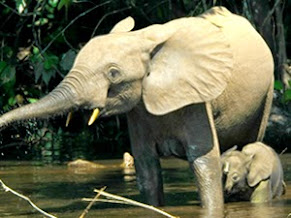Located in Ovia South LGA, the park which lies about 50km west of Benin City, Okomu National Park, formerly the Okomu Wildlife Sanctuary, is a forest block within the 1,082 km² Okomu Forest Reserve.
The park holds a small fragment of the rich forest that once covered the region, and is the last habitat for many endangered species.
The park holds a remnant of the Nigerian lowland forests that once formed a continuous 50–100 km wide belt from the Niger River west to the Dahomey Gap in Benin.
TABLE OF CONTENTS
show
OKOMU NATIONAL PARK ECO-TOURISM
To the south and southeast the forest was separated from the coast by mangrove and swamp forests, while to the north it merged into the Guinean Forest-Savanna Mosaic eco-region.
Okomu National Park is about 200 km² of wildlife sanctuary, a rainforest ecosystem that is the habitat for many endangered species of flora and fauna.
The state government formally defined the sanctuary in 1986, with an area of just 66 km2 before the Nigerian Conservation Foundation (NCF) took over management of the sanctuary in 1987, and extended it to 114 km2 by adding a one-mile wide buffer zone.
The sanctuary was later taken over by the National Parks Service in 1999.
OKOMU NATIONAL PARK ECO-TOURISM
Okomu is a home of forest elephants, buffaloes, red river hogs, chimpanzees, leopards, bush baby, putty nosed guenon, porcupine, pangolins, duikers, antelopes etc.
The white throated monkey which is one of the rarest monkeys in the world today is found at the park as well. Butterflies and birds are abundant making it one of the best places for bird watching in Nigeria.
UDO AND ARAKHUAN VILLAGES
These are the villages within the location of Okomu National Park where visitors can learn and feel life in the rural communities. The villages provide visitors an insight into authentic African village life; meeting the locals and share their historical values.
SOME FEATURES:
THE NATURE RESERVE

The park is made up of Guinea–Congo lowland rain forest, which includes areas of swamp-forest, high forest, secondary forest, and open scrub.
Common trees are Kapok, Celtis zenkeri, Triplochiton scleroxylon, Antiaris africana, Pycnanthus angolensis, Alstonia congoensis etc.
The park is probably the best example of mature secondary forest in southwest Nigeria that is home to a number of forest elephant and buffalo, as well as a large variety of primates including a small (and very wary) troop of chimpanzees. It is also home to over 700 different butterfly species.
TREEHOUSE
The park has two treehouses, one 140 feet high in a silk-cotton tree, from which visitors can view the park from above and observe bird life.
The treehouse is the most intriguing feature anyone is likely to see in the park. The houses are additional pep to visitors gaining a vintage spot from where to relax and savour the beauties of nature that the park present.
The Treehouse has a base with some measure of space and platform to sit on while contemplating how to conquer the 140 feet height.
BIRD WATCHING
With over 200 species of birds recorded at the park, Okomu National Park is very rich in birdlife. These include Angolan Pitta, Grey Parrot, Wrinkled Hornbill, Fish Eagle, Hawks and woodpeckers.
You can also find Great Owl, Grey Hornbill, Cattle Egret, Black-casqued Hornbill, Yellow-casqued Hornbill, Sabine’s Spinetail, Cassin’s Spinetail and Black Spinetail.
Other species include White-breasted Negrofinch Chestnut-breasted Negrofinch, Pale-fronted Negrofinch and Yellow-throated Cuckoo etc. The bird hide enables avid bird watchers snipe at unaware avifauna that are wading through the pool overlooked by the hide or foraging within the vicinity.
NATURE TRAIL (SAFARI)

The park is accessible to tourists, and has well marked trails for visitors.
Visitors can stay at chalets built on stilts, just outside the park entrance, surrounded by big trees that are often occupied by Mona monkeys.
Guides are available for forest walks, and will point out such things as termite nests and the many medicinal plants that can be spotted all over the Okomu forest.
It is home to endangered forest Elephants and one of the rarest monkeys in the world, the White-throated monkey is one of the few remaining pristine rainforest areas in southern Nigeria.
OKOMU AND OSSE RIVERS AND ARAKHUAN STREAM

The Okomu River which flows across the length of the park as well as the Arakhuan stream provide visitors opportunity to engage in water sports such as fishing, boating / canoeing and other water related activities.
OKOMU ECOTOURIST RESORT
Located within the Okomu National Park, Okomu Ecotourist Resort is well appointed with comfortable chalets, high class catering and bar service and a swimming pool for visitors comfort.
Situated within the lush rainforest, visitors will be able to relax to the sounds of nature or if you feel adventurous, you can explore the National Park to look out for the many animals and birds that can be found here.
Swimming pool is located at the A.P Leventis Conservation Centre at Arakhuan and it also houses artifacts and other basic materials including information about the park numerous offerings. The resort services are provided through public private partnership with private investors.
The modern tourist facilities have 12 chalets and 3 family apartments cosy restaurant and a mini conference centre. The catering services are both continental and African cuisines.
Source: Come to Nigeria
The BEST way to support us is by providing funding to enable us continue this good work:
Bank: Guarantee Trust Bank (GTBank)
Account Name: Johnson Okunade
Naira Account: 0802091793
Dollar Account: 0802091803
Pounds Account: 0802091810
Euro Account: 0802091827
Business Email — hello@johnsonokunade.com



Leave a Reply